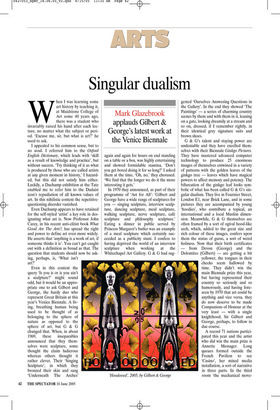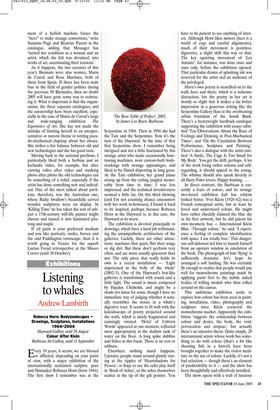Singular dualism
When I was learning some art history by teaching it, at Maidstone College of Art some 40 years ago, there was a student who invariably raised his hand after each lecture, no matter what the subject or period. ‘Excuse me, sir, but what is art?’ he used to ask.
I appealed to his common sense, but to no avail. I referred him to the Oxford English Dictionary, which leads with ‘skill as a result of knowledge and practice’, but without success. ‘Try thinking of it as what is produced by those who are called artists at any given moment in history,’ I hazarded, but this did not satisfy him either. Luckily, a Duchamp exhibition at the Tate enabled me to refer him to the Dadaist icon’s repudiation of all known values of art. In this nihilistic context the repetitivequestioning disorder vanished.
Even Duchamp appears to have retained for the self-styled ‘artist’ a key role in designating what art is. Now Professor John Carey, in his recent anti-elitist book What Good Are The Arts?, has spread the right and power to define art even more widely. He asserts that ‘anything is a work of art, if someone thinks it is’. You can’t get caught out with a definition as broad as that. The question that students should now be asking, perhaps, is, ‘What isn’t art?’ Even in this context the query ‘Is you is or is you ain’t a sculpture?’ might sound odd, but it would be an appropriate one to ask Gilbert and George, the hardy duo who represent Great Britain at this year’s Venice Biennale. A living, breathing human being used to be thought of as belonging to the sphere of nature as opposed to the sphere of art, but G & G changed that. When, in about 1969, these inseparables announced that they themselves were sculpture, some thought the claim ludicrous whereas others thought it rather clever. Their ‘Singing Sculpture’, in which they bronzed their skin and sang ‘Underneath The Arches’ again and again for hours on end standing on a table or a box, was highly entertaining and showed formidable stamina. ‘Don’t you get bored doing it for so long?’ I asked them at the time. ‘Oh, no,’ they chorused. ‘We find that the longer we do it the more interesting it gets.’ In 1970 they announced, as part of their programme of ‘Art for All’: ‘Gilbert and George have a wide range of sculptures for you — singing sculpture, interview sculpture, dancing sculpture, meal sculpture, walking sculpture, nerve sculpture, café sculpture and philosophy sculpture.’ Eating a dinner in public served by Princess Margaret’s butler was an example of a meal sculpture which certainly succeeded as a publicity stunt. I confess to having deprived the world of an interview sculpture when working at the Whitechapel Art Gallery. G & G had sug gested ‘Ourselves Answering Questions in the Gallery’. In the end they showed ‘The Paintings’ — a series of charming country scenes by them and with them in it, leaning on a gate, looking dreamily at a stream and so on, dressed, if I remember rightly, in their identical grey signature suits and brown shoes.
G & G’s talent and staying power are undeniable and they have excelled themselves with their Biennale Ginkgo Pictures. They have mastered advanced computer technology to produce 25 enormous images of themselves entwined in a variety of patterns with the golden leaves of the ginkgo tree — leaves which have magical powers to affect memory and potency. The bifurcation of the ginkgo leaf looks symbolic of what has been called G & G’s singular dualism. They live in Fournier Street, London E1, near Brick Lane, and in some pictures they are accompanied by young ‘hoodies’, who contribute a topical, an international and a local Muslim dimension. Meanwhile, G & G themselves are often framed by a sort of ogival hood-like arch, which, added to the great size and rich colour of these images, confers upon them the status of gurus, a sort of weird holiness. Now that their birth certificates — from Devon (George) and the Dolomites (Gilbert) — are getting a bit yellower, the tongues in their cheeks seem hallowed by time. They didn’t win the main Biennale prize this year, but having represented their country so seriously and so humorously, and having foreseen by 1970 that art could be anything and vice versa, they do now deserve to be made Companions of Honour at the very least — with a single knighthood, Sir Gilbert and George, perhaps, to follow in due course.
A record 71 nations participated this year and the artist who did win the main prize is Annette Messager. Long queues formed outside the French Pavilion to see ‘Casino’, her mixed media installation, a sort of narrative in three parts. In the third room ‘the mechanical move ment of a hellish machine forces the “hero” to make strange contortions,’ write Suzanne Pagé and Béatrice Parent in the catalogue, adding that Messager has ‘turned her condition as a woman and an artist, which she felt was devalued, into works of art, accentuating their tensions’.
As it happens, the two curators of this year’s Biennale were also women, Maria de Corral and Rosa Martinez, both of them from Spain. If there has been male bias in the field of gender politics during the previous 50 Biennales, then no doubt 2005 will have gone some way to redressing it. What is important is that the organisation, the three separate catalogues, and the curatorship have been excellent, especially in the case of Maria de Corral’s large and wide-ranging exhibition The Experience of Art. She has not made the mistake of limiting herself to an unrepresentative or narrow theme or writing pseudo-intellectual claptrap about her choice. She strikes a fair balance between old and new technologies and she has good taste.
Moving back to the national pavilions, I particularly liked both a Serbian and an Icelandic video, for example, but after viewing video after video and studying photo after photo the old technologies can be something of a relief, especially if the artist has done something new and individual. One of the most talked about pavilions, therefore, was the Australian one, where Ricky Swallow’s beautifully carved wooden sculptures were on display. In ‘Killing Time’ he has taken the sort of subject a 17th-century still-life painter might choose and turned it into laminated jelutong and maple.
If oil paint is your preferred medium and you like portraits, nudes, horses and the odd Paddington townscape, then it is worth going to Venice for the superb Lucian Freud retrospective at the Museo Correr (until 30 October).

















































 Previous page
Previous page